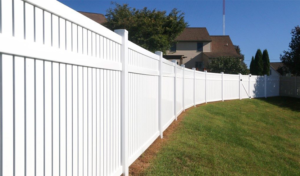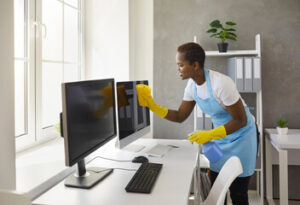Security guards patrol and monitor premises to deter theft, violence, or infractions of rules. They use conflict de-escalation techniques to diffuse situations and follow protocols to contact emergency services when necessary. Contact DMAC Security now!
Security guards work at airports, ports, transportation terminals, malls, and government facilities. They also perform entrance checks in homes, communities, and offices.

Security guards must keep themselves and others calm in high-stress situations. They also need to make good decisions on the fly. They must act immediately if they notice a potential problem, such as an unattended package or suspicious activity.
To ensure the safety of their premises, security guards patrol the area and monitor surveillance equipment. They may have to limit access to areas where sensitive information or valuable assets are kept to prevent unauthorized intrusions. Security guards also document daily activities and any irregularities in detailed reports, which are reference materials for future investigations or legal proceedings.
The presence of highly trained security professionals acts as a powerful deterrent to criminal activity. When crime is less common, people feel safer in public spaces and on commercial or industrial properties. Security guards are also trained to spot specific signs of criminal activity and respond in a way that helps prevent the crime from occurring, such as warning the person of a rule violation or detaining them until law enforcement arrives.
When a conflict arises, security guards use their conflict resolution training to de-escalate the situation and diffuse tensions. This is a critical part of their job, as it allows them to maintain order and protect the safety of all individuals involved in the incident.
In many cases, security guards may also be responsible for interacting with customers by answering their questions or providing directions. These customer service functions complement their security roles and help to build trust in the community.
Deterring Crime
Security guards monitor a property to look for vandalism, theft, fire and other incidents. They work as partners with business owners, police and fire services, observing and providing the information they need to respond quickly and effectively.
Many businesses, such as hospitals and construction sites, need a continuous security presence to deter crime. Security guards check credentials, patrol premises and monitor security cameras. They can also provide escorts to visitors, vendors and employees, and help control access to facilities. This prevents unauthorized people from entering the site and can save money from less damage and time spent on cleanups.
A security guard is a strong deterrent to potential criminals, because they are trained to watch their surroundings and are highly visible. They can spot problems and report them to law enforcement before they escalate into larger emergencies. Security guards are often able to provide valuable intelligence to police by reporting suspicious activity and helping them identify patterns of crime.
While some experts believe that security guards can act as effective deterrents in the same way as armed police officers, others argue that the distinction between the two is critical. Security guards are not armed and do not have detaining or arresting powers, and their ability to report crime is limited to their visual presence. The research suggests that they may be able to deter some crimes through their high visibility and reassurance, but they are not a replacement for policing.
The study involved uniformed security guards without weapons or detaining authority who were assigned to patrol treatment stations that had been identified by police data as prone to crime and disorder. The security guards were asked to focus on being visible and to make as many patrol visits as possible in the targeted locations. In some cases, the researchers also provided information about what had previously been reported to police at these locations, which allowed them to focus on the areas that needed the most attention.
Despite the fact that this strategy led to some crime increases at some treatment stations, overall crime and disorder did not go up during the study period. The researchers conclude that security guards can be used to supplement the work of policing, but that policymakers must carefully consider the organizational and financial implications of this approach.
Responding to Emergency Situations
Security guards must be prepared for a variety of emergencies. They undergo extensive training that prepares them for situations such as fire safety, first aid, and evacuation procedures. This training allows them to respond quickly and calmly during crises, ensuring everyone’s safety. In addition, security officers must know how to effectively communicate with individuals affected by an emergency, and with response teams and emergency services personnel to relay information clearly and accurately.
In the event of a fire, security guards must be quick to assess the situation and understand its severity. They must also be able to identify common causes of fires, such as electrical equipment malfunction or improper storage of combustible materials. They must then take the appropriate actions, which may include attempting to extinguish small fires with fire extinguishers or assisting vulnerable people, such as elderly or disabled individuals. They must also inform others of the emergency and evacuate building occupants in an orderly fashion, as well as secure the area and prevent it from spreading.
Medical emergencies are another common threat that security guards must be prepared to face. This requires extensive training in basic first aid and cardiopulmonary resuscitation (CPR). Knowing how to handle these situations empowers security guards to stabilize individuals and potentially save lives until professional medical help arrives. They are also trained in the use of emergency tools, such as automated external defibrillators (AEDs).
In a variety of emergency situations, security guards must coordinate with local emergency services to ensure people’s safety and mitigate damage. This can involve contacting 911, notifying management or security staff of the incident, and communicating with law enforcement to identify and neutralize threats. Security guards are also responsible for documenting and reporting incidents, which helps to provide important information for future investigations.
A security guard’s job duties often vary depending on the environment in which they work, and their specific role will be outlined by their employer or client. They should be familiar with the specific emergency response protocols for each location before they are assigned to that site. This will ensure that both the security guard and their employer/client are on the same page during an emergency and have the same understanding of what each person’s responsibilities are during an emergency.
Communicating With Others
Security guards must be able to interact with a diverse range of people. Effective communication skills allow them to communicate safety procedures clearly, reassure clients and employees, and answer questions in a calm and professional manner. They also use their communication skills when reporting incidents to managers and other personnel.
Security guards are frequently the first line of response to potentially dangerous situations. Their ability to convey understanding and offer non-confrontational solutions helps prevent minor disagreements from escalating into full-scale crises. It’s also vital that they be able to provide clear instructions during emergency scenarios, such as directing individuals to safety and communicating with local law enforcement and emergency services.
Verbal and written communication are important for security guards to master. Verbal communication encompasses speaking and listening, while written communication refers to reading and writing. Both are essential in the security industry, and security guards often rely on both forms of communication. Whether they are providing instructions during an evacuation, relaying information about potential threats to colleagues, or communicating with the public, security guards must be able to express themselves clearly and concisely.
To develop their verbal communication skills, security guards should take communications classes or practice using role-playing scenarios to improve their ability to articulate messages clearly and calmly. They should also work on their active listening and empathy skills, as these are critical to fostering positive relationships with the people they interact with. This includes paying close attention to the speaker’s body language, facial expressions, and proxemics, as well as asking open-ended questions to better understand their perspective.
It’s also important for security guards to be able to read and interpret non-verbal cues, as these can indicate a potential threat or a person’s state of mind. This may include noticing nervous behaviour, such as crossing the arms or avoiding eye contact, which could be signs of hostility or deception. In addition, they should learn to notice subtle cues such as sweating and breathing rate, which can indicate stress.
In some cases, security guards must also be able to write clear, concise reports. This can include incident reports, logs, or memos. They may also need to write emails or letters, so it’s important that they have good written communication skills as well.


